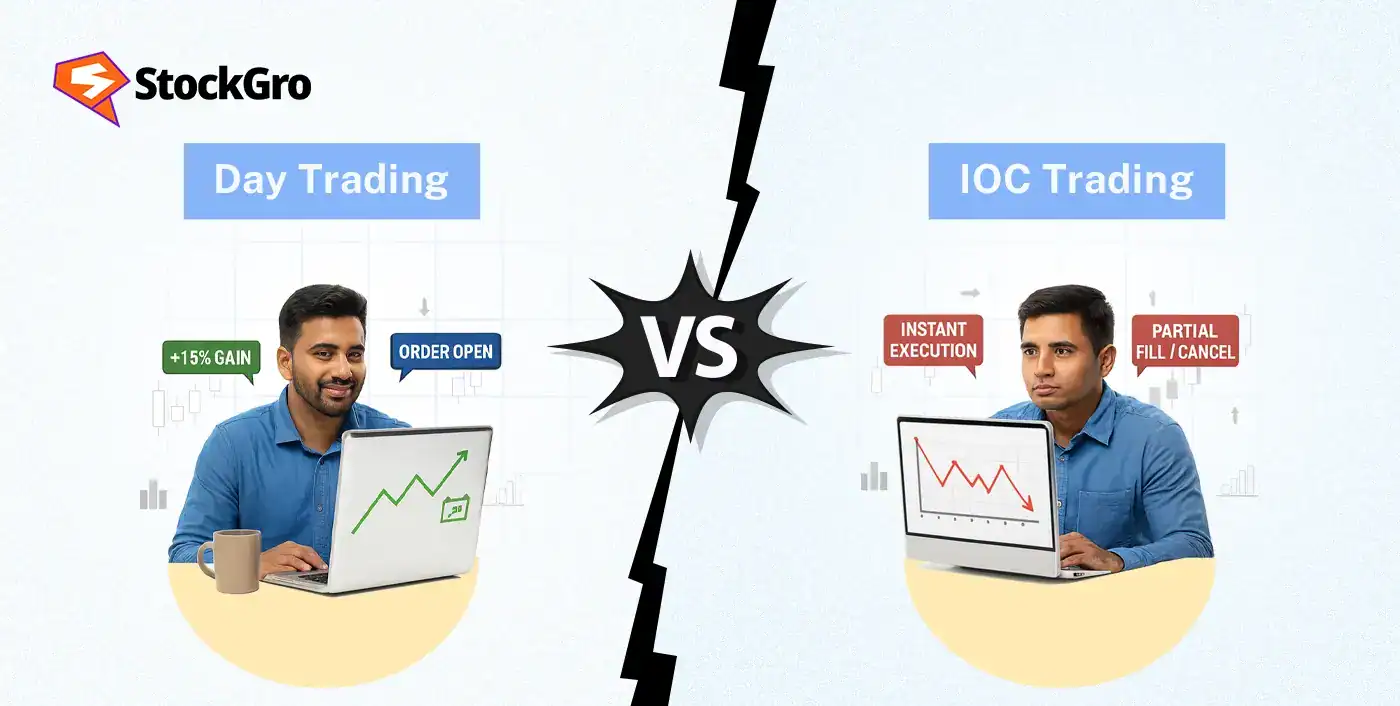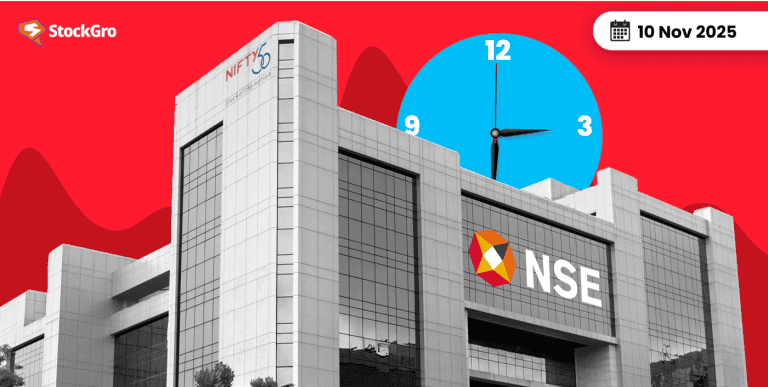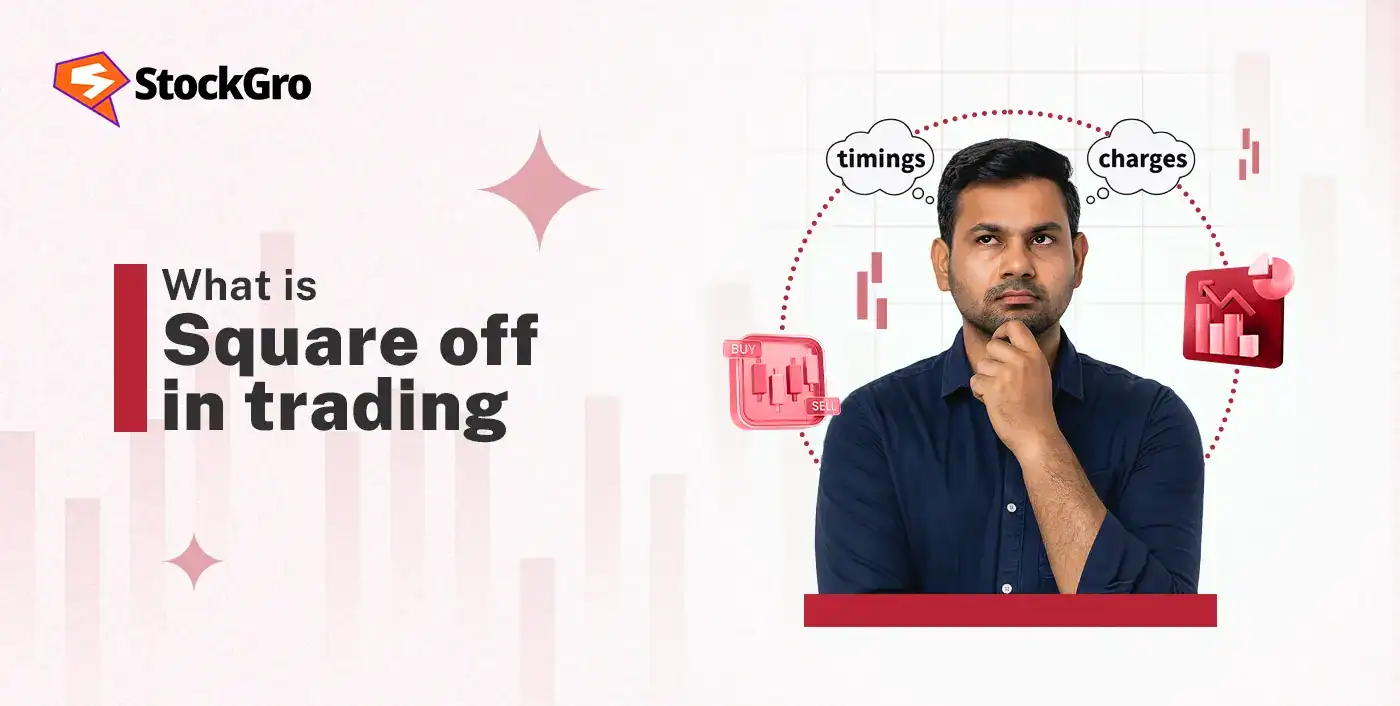
You might place a stock order expecting it to execute quickly, only to find it still pending or cancelled without reason. Such confusion often comes from not understanding how order validity works in trading. This is where knowing what is day order and IOC in trading becomes essential for clarity and control. As per NSE data, IOC orders accounted for only around 3% of total non-algorithmic trades before regulatory changes, showing how selectively traders use them. To know how these order types differ and why they matter, read the blog.
What is a Day Order?
A day order is an instruction to buy or sell a stock that stays active only for the trading day on which it is placed. Understanding the day order definition helps clarify that such an order automatically expires if it is not executed by market close. This type of day order in trading is the default option on most trading platforms, allowing a trader to set a specific price (as in a limit order) and wait for the market to reach that price anytime during the day.
What is an IOC Order?
An IOC short for immediate or cancel order is an instruction to buy or sell a stock that must be filled immediately. Right after an order is placed in the market, the exchange works to complete the trade. Portions of the order that don’t get matched immediately are removed from the system. An IOC order in trading does not wait in the system. This means the trader might get the full quantity, a partial quantity, or nothing at all, but the action is instant.
Key Differences Between Day and IOC Orders
Day orders and IOC orders are two different time-in-force orders that tell the exchange how long an order should remain active. The main differences between these trading strategies are:
| Feature | Day order | IOC order (immediate or cancel) |
| Validity | Remains active until the market closes for the day. | Canceled immediately if not filled (or partially filled) instantly. |
| Execution | Execution can happen anytime throughout the active trading hours. | The exchange executes the order immediately, either in full or for the available quantity. |
| Partial fills | Can be partially filled, with the remaining order staying active. | The unfilled part of the order is immediately canceled. |
| Waiting | The order waits in the market system for a matching price. | The order does not wait; it is an “execute or cancel” instruction. |
| Purpose | Used when the trader is willing to wait for a specific price. | Used for quick execution to capture a current price without waiting. |
These trading order types are used in different situations. A day order is patient, waiting for the desired price. An IOC order is impatient, demanding an immediate fill. The choice between them depends on the trader’s goal, whether it is getting a specific price (like a limit order) or getting the trade done quickly (which can be done with a market vs limit order).
When to Use Day Orders
A person might choose to use a day order in several situations, such as:
- When price is more important than speed: If a person wants to buy or sell at a specific price (a limit order) and is willing to wait the entire day for the market to reach that price. They are not in a hurry and prioritise getting their price over immediate execution.
- For non-urgent trades: If the trade does not need to happen immediately, a day order gives it the maximum time within one session to be completed. It’s a standard choice for typical buy or sell requests.
- To set and forget (for the day): A person can place the order in the morning and not worry about it being active the next day if it’s forgotten. It provides a natural daily reset, cleaning up any unfilled orders.
- For common stocks with good volume: In markets where prices move back and forth (have volatility), a day order has a good chance of being filled as the price fluctuates throughout the session.
- To avoid overnight risk: Since the order cancels at close, it prevents an order from being unexpectedly filled at the market open the next day. Overnight announcements or global events often cause the opening price to differ from the last day’s close.
When to Use IOC Orders
An IOC Order is used in specific, time-sensitive situations, which include:
- When executing large orders: If a person needs to buy or sell a very large number of shares, using an IOC order can prevent the large order itself from moving the market price. It grabs all available shares instantly without sitting in the order book, which could signal the large trade to others.
- To avoid partial fills left open: It is used when a person wants to fill what they can right now but does not want the remaining, unfilled part of the order to stay active. This avoids having to manually cancel the rest later.
- During high-speed trading: In swift markets or when reacting to sudden news, an IOC order ensures the trade happens instantly or not at all, preventing a “missed price.”
- To check for available shares (liquidity): An IOC order can be used to test the market and see how many shares are available at the current price without committing to an order that waits and might be filled at a worse price later.
- When speed is the primary priority: If getting the trade done immediately is more important than getting the entire order filled, an IOC is the right choice.
Pros and Cons of Day and IOC Orders
Both order types have their own benefits and drawbacks. The pros and cons of day orders include:
| Pros | Cons |
| The order remains active throughout the day, giving more time for execution at the desired price. | There is no guarantee that the order will be executed before the market closes. |
| Works well with limit orders, allowing trades at specific price levels instead of the market price. | The order expires automatically at market close, even if the target price is close to being met. |
| Simple and widely used; suitable for non-urgent trades that can wait through the day. | May miss short-lived price movements if the market touches the price only briefly. |
Whereas, the pros and cons of IOC orders are as follows:
| Pros | Cons |
| Executes instantly, providing immediate clarity on whether the order was filled or cancelled. | The order might get partially filled, leaving the rest unexecuted. |
| Saves time since there’s no need to track or cancel pending orders later. | The order could be cancelled entirely if no matching price is available at that exact moment. |
| Helps maintain price discipline in fast-moving markets by avoiding delayed fills at unfavourable prices. | May miss later opportunities if the order gets cancelled just before suitable prices appear. |
Real-World Examples and Case Studies
The Jane Street–Bank Nifty scandal serves as a landmark case study on how advanced order types, especially immediate or cancel (IOC) and day orders can be used in manipulative ways, leading to severe consequences for market fairness and retail investors.
Between January 2023 and March 2025, Jane Street, a U.S.-based proprietary trading firm, systematically influenced the Bank Nifty index on 18 expiry days by executing large volumes of trades in bank stocks and futures, often using IOC orders for rapid execution. Their strategy was twofold:
- Morning phase: The firm bought substantial quantities of Bank Nifty constituent stocks and futures, artificially pushing up the index and creating a misleading sense of upward price movement.
- Closing phase: Later in the session, they sold off these long positions, causing a sharp fall in prices while profiting from short positions built earlier in Bank Nifty options.
According to SEBI’s investigation, Jane Street’s trades contributed to over 20% of the total traded value in key banking stocks on certain days, significantly distorting price discovery and misleading retail participants. The regulator determined that these activities did not represent legitimate arbitrage but rather an orchestrated attempt to manipulate settlement prices and extract unlawful gains.
As a result, SEBI ordered Jane Street to deposit ₹4,843 crore (approximately $580 million) as alleged illicit profits and barred the firm from participating in the Indian securities market pending further action.
This case shows how IOC and Day Orders, when misused by large, algorithmic players, can create artificial price movements, disadvantage retail investors, and erode trust in market integrity. It highlights the importance of robust surveillance, transparent reporting, and regulatory vigilance to prevent such manipulation and safeguard investor confidence.
Conclusion: Choosing the Right Order Type for Your Strategy
Your order type is your intention. A Day order patiently waits for its price; an IOC demands instant action. This choice is crucial for risk and execution. Learning what is day order and ioc in trading isn’t just technical, it’s about implementing your strategy with purpose and avoiding costly mistakes, ensuring your plan is followed to the letter.
FAQ‘s
A day order is an instruction to buy or sell a security valid only for the trading day it is placed. If the order is not fully executed by market close, it is automatically canceled. It allows traders to set a target price and wait during the day.
Yes, you can place an Immediate or Cancel (IOC) order for any security available on the stock exchange, subject to the broker’s platform capabilities and market regulations. It ensures that the order is filled immediately, wholly or partially, or else canceled instantly.
An IOC order executes instantly upon reaching the market. It fills as much of the order as possible immediately at the current price. Any unfilled portion is automatically canceled. This prevents pending or open orders from lingering in the system if not fully matched.
Day orders give flexibility to execute trades during the full trading session and are useful when price targeting is more important than speed. IOC orders suit high-speed trading where instant execution or cancellation is important, helping traders avoid unwanted partial fills or delays.
A day order remains active throughout the trading day and cancels only if unfilled by market close. An IOC order requires immediate execution; any portion not filled instantly is canceled. Thus, Day orders wait for matching prices, while IOC orders demand immediate action or cancellation.
IOC orders provide speed, preventing market impact from large pending orders by executing fast or canceling. They allow partial fills without lingering open orders, reduce manual cancellation, and suit traders needing rapid execution amid volatile or fast-moving markets.
Use a day order when you prioritise price over timing, are patient for a trade at your target price within the day, want non-urgent trade execution, or prefer not to risk overnight market fluctuations. Day orders accommodate typical buying/selling needs during trading hours.

